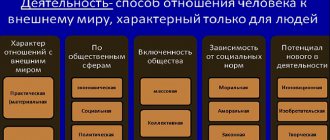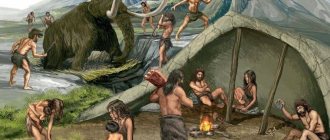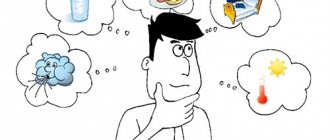In the modern world, the concept of “activity” is defined as the purposeful active influence of a living being on objects of the surrounding world or interaction with them. However, if the actions of representatives of the animal world are formed by behavioral reactions provoked by unconscious natural needs of life support, then human activity is a free and conscious phenomenon. It can be either primitive, serving to satisfy the same primary needs, or have more complex levels of formation that arise due to the cultural and historical development of society.
↑ Types of activities
Depending on the subject, activity can be individual
or
collective
.
By nature: reproductive
(repeating what has already been achieved) and
productive
- creative (a type of activity that generates something qualitatively new, never existing before).
According to social norms: legal - illegal, moral - immoral
.
In relation to social progress: progressive - reactionary, creative - destructive.
In the sphere of public life: economic, social, political, spiritual.
According to the characteristics of the manifestation of human activity: external - internal.
The main types of activities that ensure the existence of a person and his formation as an individual are communication, play, learning and work
.
Functions of spiritual production
Spiritual production, in its current form being universal and multifunctional, is brought to life with the goal of satisfying needs. Despite all the versatility of this concept, a holistic, indivisible main guideline of spiritual production is maintained - the reproduction of the collective mind in its indivisibility.
The key function of moral creation is personal activity aimed at improving the quality of other areas of social life:
- economics;
- politicians;
- public life.
The name “production of new technologies” given to this meaning by some scientists is not entirely correct. This means savings taking into account the modernization of existing technologies, which include social ones.
It is necessary to differentiate between utilitarian designs that ennoble the everyday improvement of life, and capital theories that can undermine old technologies and aim at previously unknown landmarks. Examples of such completely new concepts are the theory of relativity in science or the concept of messianism in religion.
↑ Communication as a type of activity
Communication
- a type of activity during which information is transferred from one individual to another, thoughts, feelings and emotions are exchanged.
It is often expanded to include the exchange of material items. This broader exchange constitutes communication.
Communication
— communication, the transfer of information from person to person, a form of interaction between people.
Communication structure:
Subjects
- those between whom communication takes place (individuals, groups, communities, humanity as a whole)
Target
- this is what a person needs to communicate for
Content
- these are ideas, emotions that are transmitted in interpersonal contacts from one to another
Facilities
- these are methods of transmission (using the senses, texts, drawings, diagrams, radio-video equipment, the Internet, etc.)
Same thing again
Communication
is a process of interaction between people, as a result of which information, emotions, and moods are transferred.
Subjects
: Really existing partners; illusory partners (they are assigned qualities of a subject of communication that are unusual for them, for example, talking with a pet); imaginary partners (talk to oneself, with an artistic image)
Goals
(that for which a person has a need for interpersonal relationships): transfer and receipt of knowledge; coordination of reasonable actions of people; organization of joint activities of people; establishing and clarifying interpersonal relationships, etc.
Content
(information transmitted in the process of communication): knowledge, experience, skills, emotions, feelings
Communication means
(methods of transmission, processing and decoding of information):
- sense organs (vision, hearing, smell, touch);
- oral speech;
- written language (drawings, signs, images);
- technical means (radio, television, computer)
functions
:
- communicative
(implementation of the relationship between people at the level of individual, group and public interaction); - cognitive
(obtaining new information); - socialization
(formation of interaction skills in society); - psychological
(emotional support);
Types of communication
| Direct - personal contact, communication requires visual perception of each other | Business (formal) - communication in the professional sphere, relies more on document flow. | Verbal - communication through speech. | Interpersonal - communication between two people. |
| Indirect - communication through other people. | Personal (informal) - conversation on any topic, communication between friends and loved ones. | Nonverbal - communication through facial expressions, gestures, postures. | Group - communication between three or more people. |
Human needs
It is said above that activity is a conscious process endowed with meaning. That is, if you do something, you understand why you need it . How is meaning born? Initially, you realize that you need something.
For example, your stomach growls, you realize a need - hunger - and go to the kitchen to prepare food for yourself. If you did not understand your feelings, and specifically, did not recognize the feeling of hunger, then no further action would have followed.
Thus, a need is a need for something.
There are many classifications of this phenomenon, but the most frequently used is “Abraham Maslow’s pyramid of needs” (American behavioral psychologist).
Studying human behavior, he came to the conclusion that in addition to short-term needs (buying a car), which change throughout life, there are basic needs . The latter represent the basis of a happy existence, provided they are satisfied.
- Physiological - the simplest, but vital needs - sleep, food, air, clothing, etc. This is the very first, primitive level (this is how newborns live).
- The need for security is necessary for mental peace, because only then can we develop effectively and feel comfortable (the parents are called upon to provide this need to the child).
- Social needs are variously expressed desires to be with people, to feel part of a family, class, group, country, to belong to people like me. A person cannot live and develop outside of society (adolescents).
- Esteem Need – We want to be leaders, valued members of society, loved and appreciated (by adults).
- The need for self-actualization or self-expression is the highest level of needs, which not everyone achieves. Here the individual needs creative development, dissemination of his skills and knowledge, thus expressing his inner “I” (mature people).
A little later, Maslow supplemented his classification with three more types of needs: cognitive (the desire to explore, discover), aesthetic (the desire for harmony and beauty) and transcendental (the selfless transfer of one’s own experience for the purpose of self-improvement of other people).
↑ Game as a type of activity
A game
- this is a type of activity that is aimed at satisfying spiritual needs and the goal of which is not the production of a material product, but the process itself - relaxation, entertainment.
Characteristic features of the game:
- Occurs in a conditional situation, which, as a rule, changes quickly.
- Certain items are used during the game
- Aimed at satisfying the interests of its participants
- Promotes personality development, enriches it, equips it with the necessary skills.
↑ Labor as a type of activity
Work
is a human activity aimed at obtaining a practically useful result, which makes it possible to satisfy one’s needs.
In the process of labor activity, a person produces the material and spiritual values he needs. Unlike study and play, work requires a person to have certain training or qualifications,
for example: a miner cannot perform a surgical operation.
Qualification -
the level of knowledge, abilities, skills and competence that characterizes readiness to perform a certain type of professional activity.
Characteristic features of work:
- Feasibility
- Focus on achieving programmed expected results
- Availability of skills, abilities, knowledge.
- Practical usefulness
- Availability of result
- Personal development
- Transformation of the external human environment
Types of professions by subject of work
A profession is a type of human labor activity that requires possession of theoretical knowledge and practical skills. This knowledge and skills are acquired by receiving special education.
There are 5 objects of labor: man, technology, artistic image, sign, nature. In this case, a person acts as a subject of labor.
A person is a person . Education, training, service, communication with people. Professions of medicine and teaching, service sector workers.
Man is technology . Working with equipment and materials. For example: car mechanic, engineer, programmer.
Man is an artistic image. Representatives of these professions create, reproduce artistic images, and study them. Musician, painter, artist, writer, museum curator.
Man is nature. Interaction with nature. This is a biologist, landscape designer, geologist.
Man is a sign. Use of sign systems (letters, numbers, notes, symbols). For example: translators, linguists, composers, financiers, programmers.
Now it is difficult to find a profession that would correspond to this typology in its pure form. Modern professions operate with several subjects of labor. For example, a composer simultaneously interacts with notes and with an artistic image. The programmer relies on both technology and signs.
↑ Material and spiritual activity
Based on objects and results, activities are divided into material and spiritual.
Material (practical) activities
associated with practice, creating something new or changing the old order of things.
Material activity, in turn, is divided into two main groups: material-production and social-transformative.
Material and production
activity represents the creation of material wealth, the enrichment of the culture of humanity as a whole. For example, construction, factory production, crafts.
Social transformative activities
associated with changes in society. This type of activity includes the publication of new legislative acts and implementation of reforms.
Spiritual activity
is a process associated with intelligence and creativity, aimed at the spiritual development of the world.
It includes cognitive, value-oriented and prognostic activities.
Cognitive (educational and cognitive)
activities are associated with obtaining new knowledge about the world, events and patterns.
The establishment and formation of spiritual values in society or a value-based attitude towards things is a value-oriented activity
.
Prognostic activity
- making forecasts or plans for the future, foreseeing the results of one’s actions or future events.
The results of spiritual activity are new ideas, values, ideas, which are subsequently embodied in philosophical concepts, scientific theories, works of art, moral, religious, legal and other norms.
Historical forms of spiritual activity are religion, morality, art, science, philosophy, law, political ideology, and spiritual production
- this is the result of activity in these areas, namely spiritual values and benefits.
Spiritual production -
production of spiritual values, those. ideas, ideas, scientific knowledge, ideals, as well as the entire system of human activity associated with this process.
Activities may also vary in nature. Thus, they distinguish the conscious
(conscious setting of goals and their achievement),
productive
(creation of a useful product),
instrumental
(creation of tools),
transformative
(changing the environment, society, self-improvement) and
social
(interaction with people)
nature of activity
.
Creative or productive activities
Creativity is a transformative activity that results in a new product. A work of creativity is unique, has spiritual and material value, brings new knowledge, inventions, works of art.
The process of creative activity:
- combining technologies and creative work tools;
- inclusion of imagination, creation of mental images in the imagination of the subject of activity;
- the presence of imagination, the ability to consciously and unconsciously draw vivid and unusual images and situations in the imagination;
- intuition is the ability to foresight, comprehending the truth not through inference and logic.
A creative person is endowed with special abilities. But despite this, creating something new requires persistence, perseverance, and efficiency. Achieving a goal requires work and experience. Creative intuition only works when the stages of preparation, reflection, hard work and testing have been completed.











